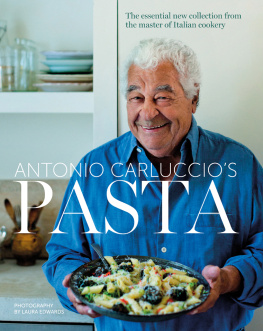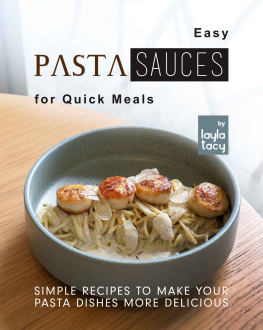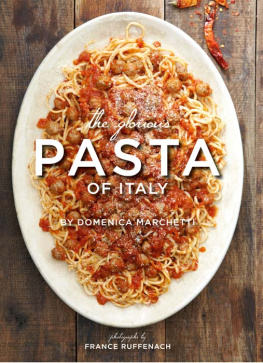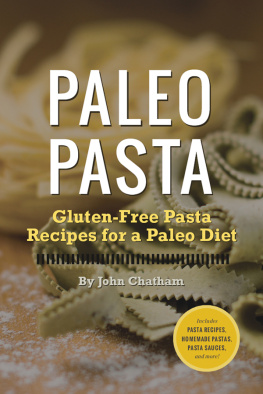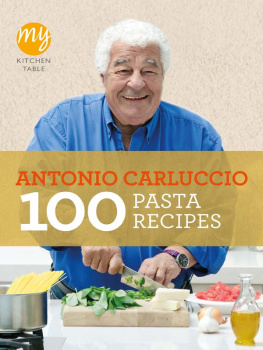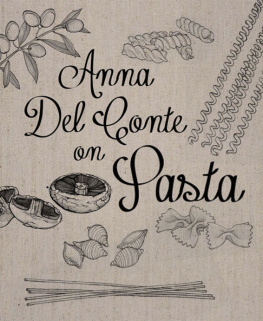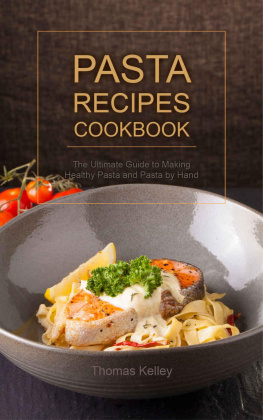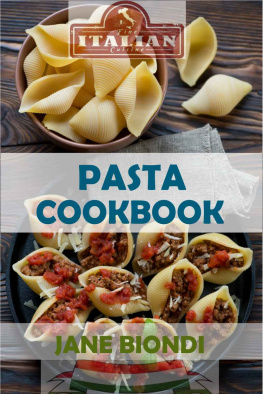



ANTONIO
CARLUCCIOS
PASTA
Photography by Laura Edwards
Quadrille
PUBLISHING

EDITORIAL DIRECTOR Jane OShea
CREATIVE DIRECTOR Helen Lewis
PROJECT EDITOR Simon Davis
EDITOR Susan Fleming
ASSISTANT EDITOR Romilly Morgan
PROJECT DESIGN & ART DIRECTION Claire Peters
DESIGN ASSISTANT Emily Lapworth
PHOTOGRAPHER Laura Edwards
PHOTOGRAPHERS ASSISTANT Kim Lightbody
FOOD AND PROPS STYLIST Anna Jones
FOOD STYLISTS ASSISTANT Emily Ezekiel
PRODUCTION James Finan, Vincent Smith
First published in 2014 by
Quadrille Publishing Limited
Alhambra House
2731 Charing Cross Road
London WC2H 0LS
www.quadrille.co.uk
Text 2014 Antonio Carluccio
Photography 2014 Laura Edwards
Design and layout 2014 Quadrille Publishing Limited
The rights of the author have been asserted.
All rights reserved. No part of this book may be reproduced, stored
in a retrieval system or transmitted in any form or by any means,
electronic, electrostatic, magnetic tape, mechanical, photocopying,
recording or otherwise, without the prior permission in writing
of the publisher. Cataloguing in Publication Data: a catalogue record
for this book is available from the British Library.
ISBN 978 1 84949 525 7

Introduction
PART ONE ALL ABOUT PASTA
The History of Pasta
What is Pasta?
Types of Pasta
Pasta and Sauces
Pasta and the Italian Kitchen
Making Fresh Pasta
The Pasta Code
PART TWO THE PASTA RECIPES
Pasta in Brodo {Pasta in Soups}
Pasta Asciutta {Pasta with Sauces}
Pasta Fresca e Ripiena {Fresh and Filled Pasta}
Pasta al Forno {Baked Pasta}
Insalate di Pasta e Riciclaggi {Pasta Salads and Leftovers}
Pasta come Dolce {Pasta as Dessert}
A List of Pastas
Index
Acknowledgements


For an amazing seven decades I have been loving,
making, cooking and eating pasta! I know that my
pasta-consuming career must have started more than
70 years ago, because I would have eaten pasta shortly
after I was born in 1937. The first solid that Italian
babies enjoy, after about four months, is inevitably
pasta, which in my case and in the lives of many other
Italians marked the beginning of a lifelong passion.
No other food is more Italian and more satisfactory
to eat than pasta. Pasta can be prepared at any time,
anywhere in the world, in any situation, for any
occasion, and can be presented as a snack or main
course, a complete meal or even as a dessert. It can be
made fresh from a combination of wheat flour and
water only, perhaps with the addition of egg but, and
this is the most significant thing about pasta, it can also
be bought dried, when it is made from the self-same
ingredients, so it is very readily available. It can also
be cooked in minutes whether, long, short, straight
or convoluted and its variety of shapes can be served
with a multitude of different sauces.
Pasta is also very healthy, although it has not always
enjoyed such a good reputation. In the 1960s and
1980s, pasta was accused of being responsible for the
spreading waistlines of many Italians. There were
cries to ditch it as a staple food until some eminent
nutritionist from America brought the welcome news
that pasta, eaten with consideration, is an excellent
food and a valued part of the famed Mediterranean
diet. Indeed, pasta is considered one of the most
versatile ways of gaining energy from food: it is
basically a carbohydrate, but is easy to digest. It also
takes a long time to digest, so its slow-release energy
is invaluable to athletes: I believe, for instance, that
many marathon runners eat a large plate of pasta some
time before their race, as do rugby players before an
important game. With the addition of fat, meat, fish
or cheese, a pasta meal provides protein, while the
tomato and other vegetables in the sauces give the body
necessary amino acids, calcium and precious vitamins.
Because of the increasing popularity of pasta, it has
assumed the status of piatto unico a complete meal
making the classic Italian meal of three to four courses,
especially on a daily basis, superfluous. I dont need
to say how beneficial this might be to the weight and
health levels of the average Italian I must admit,
though, being the age I am, that I still like to eat a little
pasta, at certain meals, in between the antipasto and
the meat or fish course.
I have written eighteen books on Italian cooking,
each of which has mentioned pasta, and one of which
specialised in pasta itself. It may seem repetitious
to be producing yet another, but there are so many
possibilities in the culinary pasta palette, that I thought
(with the encouragement of my publisher) that we
could produce something that would still be of value.
There are, after all, more than 600 shapes of pasta
produced in Italy, with perhaps even more varieties
of sauces, so there are a few ways in which to explore
new territory! It is obviously impossible to ignore
the very classic Italian pasta dishes, so those few are
here again, albeit in a slightly different form, but they
are accompanied by many which are new, created
completely afresh by myself, or newly adapted from
regional and national recipes which reflect the many
aspects of authentic Italian cuisine.
The most important thing that I would like to give
you all is a taste of the experience, love and passion
I possess, which will help to make it easy for you to
reproduce some of these pasta dishes for yourself. I
wont be upset if, in some cases, you use more or less of
my suggested ingredients. I would, however, be a little
hurt if you added garlic and oregano to a bolognese
sauce. That is a step too far for me
So in this book I hope I am able to distill my pasta
knowledge the recipes, tips and secrets I have
collected with passion over the last fifty years, in order
to allow you to recreate, in many different ways, this
most popular and delicious dish in the world.
Good luck and buon appetito!

PART ONE
ALL ABOUT
PASTA
 Next page
Next page
